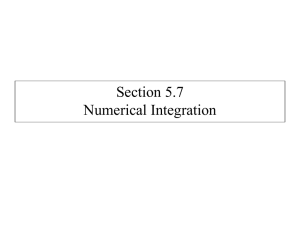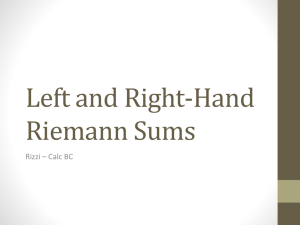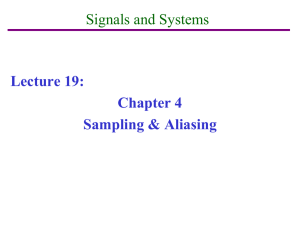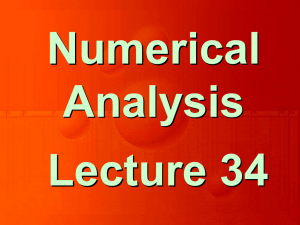Trapezoidal Approximation
advertisement
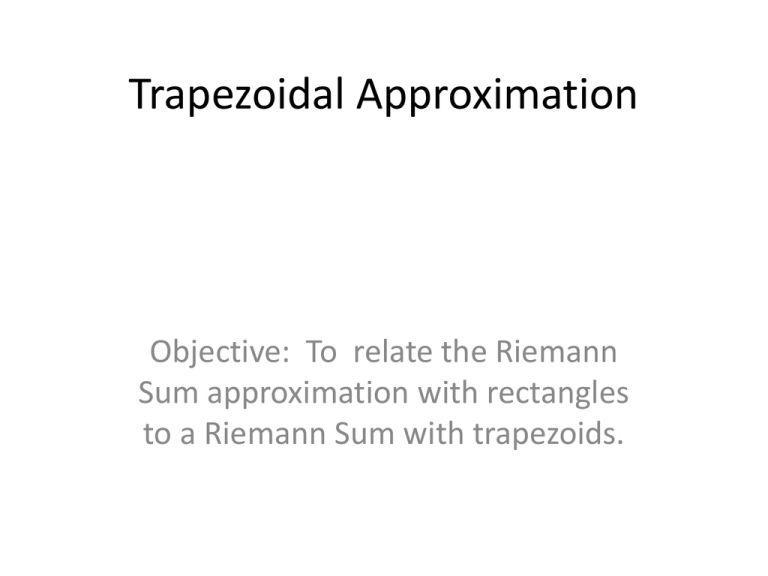
Trapezoidal Approximation Objective: To relate the Riemann Sum approximation with rectangles to a Riemann Sum with trapezoids. Trapezoidal Approximation • We will now look at finding area by using trapezoids rather than rectangles. Remember, the area of a h trapezoid is A ( b b ) . In the picture below, the 2 height of each trapezoid is x . The bases of each trapezoid are the parallel sides. For us, this will be the value of the function evaluate at the endpoints of each “strip.” 1 2 Trapezoidal Approximation • For example, the area of the first trapezoid would be: height x A 2 A1 1 n 2 b 2 y1 b1 y 0 h ba ( b1 b 2 ) ba 2n ( y 0 y1 ) height 1 2 x ba 2n ( b1 b2 ) ( y 0 y1 ) Trapezoidal Approximation • For example, the area of the second trapezoid would be: A1 A2 ba 2n ba 2n ( y 0 y1 ) ( y1 y 2 ) Trapezoidal Approximation • For example, the area of the third trapezoid would be: A1 A2 A3 ba 2n ba 2n ba 2n ( y 0 y1 ) ( y1 y 2 ) ( y2 y3 ) Trapezoidal Approximation • For example, the area of the nth trapezoid would be: A1 A2 A3 An ba 2n ba 2n ba 2n ba 2n ( y 0 y1 ) ( y1 y 2 ) ( y2 y3 ) ( y n 1 y n ) Trapezoidal Approximation • When adding these areas together and factoring out the common b a it becomes A1 A3 A ba 2n ba 2n ba 2n 2n ( y 0 y1 ) ( y2 y3 ) A2 An ba 2n ba 2n ( y1 y 2 ) ( y n 1 y n ) ( y 0 y1 y1 y 2 y 2 y 3 ... y n 1 y n ) Trapezoidal Approximation • Notice how each value of y is used twice except for the first and last ones. This leads us to another form of the equation. A ba 2n A ba 2n ( y 0 y1 y1 y 2 y 2 y 3 ... y n 1 y n ) ( y 0 2 y1 2 y 2 2 y 3 ... 2 y n 1 y n ) f ( x ) dx T n ba 2n ( y 0 2 y1 2 y 2 2 y 3 ... 2 y n 1 y n ) Example • Selected values of a continuous function are given in the table. Using 10 subintervals of equal length, the Trapezoidal Rule approximation for f ( x ) dx is 10 0 Example • Selected values of a continuous function are given in the table. Using 10 subintervals of equal length, the Trapezoidal Rule approximation for f ( x ) dx is 10 0 ba 2n 10 0 f ( x ) dx 10 0 2 (10 ) 1 2 1 2 20 2 (19 . 5 ) 2 (18 ) 2 (15 . 5 ) 2 (12 ) 2 ( 7 . 5 ) 2 ( 2 ) 2 ( 4 . 5 ) 2 ( 12 ) 2 ( 20 . 5 ) ( 30 ) 10 0 f ( x ) dx 32 . 5 Example • Using the subintervals [1, 5], [5, 8], and [8, 10], what is the trapezoidal approximation to ? ( 2 cos x ) dx 10 1 a )17 . 126 b )17 . 129 c )17 . 155 d )18 . 147 e )19 . 386 Example • Using the subintervals [1, 5], [5, 8], and [8, 10], what is the trapezoidal approximation to ? ( 2 cos x ) dx 10 1 • Trap 1 5 1 2 [( 2 cos 1) ( 2 cos 5 )] 6 . 352 • Trap 2 • Trap 3 85 2 10 8 2 [( 2 cos 5 ) ( 2 cos 8 )] a )17 . 126 b )17 . 129 c )17 . 155 5 . 7927 d )18 . 147 [( 2 cos 8 ) ( 2 cos 10 )] e )19 . 386 4 . 9846 Example • Using the subintervals [1, 5], [5, 8], and [8, 10], what is the trapezoidal approximation to ? ( 2 cos x ) dx 10 1 • Trap 1 5 1 2 [( 2 cos 1) ( 2 cos 5 )] a )17 . 126 b )17 . 129 • Trap 2 85 2 [( 2 cos 5 ) ( 2 cos 8 )] c )17 . 155 d )18 . 147 • Trap 3 10 8 2 [( 2 cos 8 ) ( 2 cos 10 )] e )19 . 386 Example • If three equal subdivisions of [0, 3] are used, what is the Trapezoidal Rule approximation of ( x 6 x 9 ) dx ? 3 2 0 a )3 b )9 c )9 .5 d )10 e )19 Example • If three equal subdivisions of [0, 3] are used, what is the Trapezoidal Rule approximation of ( x 6 x 9 ) dx ? 3 2 0 • Trap 1 1 2 [9 4 ] 6 .5 a )3 b )9 • Trap 2 1 2 [ 4 1] 2 . 5 c )9 .5 d )10 • Trap 3 1 2 [1 0 ] . 5 9 .5 e )19

